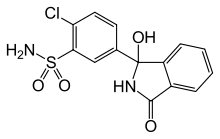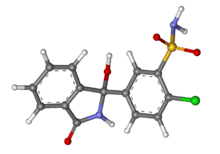Chlortalidone
 | |
 | |
| Clinical data | |
|---|---|
| Trade names | Generic, many tradenames worldwide[1] |
| AHFS/Drugs.com | Consumer Drug Information |
| MedlinePlus | a682342 |
| Pregnancy category | |
| Routes of administration | Oral |
| ATC code | |
| Legal status | |
| Legal status |
|
| Pharmacokinetic data | |
| Protein binding | 75% |
| Biological half-life | 40 hours |
| Excretion | Renal |
| Identifiers | |
| |
| CAS Number | |
| PubChem CID | |
| IUPHAR/BPS | |
| DrugBank | |
| ChemSpider | |
| UNII | |
| KEGG | |
| ChEBI | |
| ChEMBL | |
| ECHA InfoCard | 100.000.930 |
| Chemical and physical data | |
| Formula | C14H11ClN2O4S |
| Molar mass | 338.766 g/mol |
| 3D model (JSmol) | |
| Chirality | Racemic mixture |
| |
| |
| (verify) | |
Chlortalidone (INN/BAN) or chlorthalidone (USAN) is a diuretic drug used to treat hypertension, originally marketed as Hygroton in the USA. It is described as a thiazide diuretic (or, rather, a thiazide-like diuretic because it acts similarly to the thiazides but does not contain the benzothiadiazine molecular structure). Compared with other medications of the thiazide class, chlortalidone has the longest duration of action but a similar diuretic effect at maximal therapeutic doses. It is often used in the management of hypertension and edema.
Unlike loop diuretics, chlortalidone efficacy is diminished in patients with certain renal diseases (e.g. chronic renal disease). A clinical trial (ALLHAT) in 2002 compared chlortalidone to doxazosin in the treatment of high-risk hypertensive patients. In this study, only chlortalidone significantly reduced the risk of combined cardiovascular disease events, especially heart failure, when compared with drugs such as doxazosin.[2] Chlortalidone was approved by the FDA in 1960. The ALLHAT study conclusions showed that there was no significant difference in all-cause mortality, fatal heart disease, or non-fatal myocardial infarction when chlortalidone was compared with lisinopril or amlodipine but did show decreased rates of heart failure after 6 years when compared with amlodipine and decreased rates of cerebrovascular disease after 6 years when compared with lisinopril leading the study conclusions to say that thiazide-type diuretics are preferred first-step in antihypertensive therapy.
In terms of activity, chlorothalidone is very similar to hydrochlorothiazide and is used as an independent drug or in combination with other antihypertensive agents for lowering arterial blood pressure, and also as an adjuvant drug for treating edema caused by cardiac insufficiency and renal irregularities, including nephrotic syndrome.
Mechanism of action
Chlortalidone prevents reabsorption of sodium and chloride by inhibiting the Na+/Cl− symporter in the distal convoluted tubule. Thiazides and related compounds also decrease the glomerular filtration rate, which further reduces the drug's efficacy in patients with kidney impairment (e.g. kidney insufficiency). By increasing the delivery of sodium to the distal renal tubule, chlortalidone indirectly increases potassium excretion via the sodium-potassium exchange mechanism (i.e. apical ROMK/Na channels coupled with basolateral NKATPases). This can result in hypokalemia and hypochloremia as well as a mild metabolic alkalosis; however, the diuretic efficacy of chlortalidone is not affected by the acid-base balance of the patient being treated.
Initially, diuretics lower blood pressure by decreasing cardiac output and reducing plasma and extracellular fluid volume. Eventually, cardiac output returns to normal, and plasma and extracellular fluid volume return to slightly less than normal, but a reduction in peripheral vascular resistance is maintained, thus resulting in an overall lower blood pressure. The reduction in intravascular volume induces an elevation in plasma renin activity and aldosterone secretion, further contributing to the potassium loss associated with thiazide diuretic therapy.
Banned for some sports
Chlortalidone is banned for some sports (including cricket) because it is a diuretic.[3]
See also
References
- ↑ drugs.com drugs.com international listing of Chlortalidone Page accessed May 13, 2015
- ↑ ALLHAT Officers and Coordinators for the ALLHAT Collaborative Research Group (18 December 2002). "Major outcomes in high-risk hypertensive patients randomized to angiotensin-converting enzyme inhibitor or calcium channel blocker vs diuretic: The Antihypertensive and Lipid-Lowering Treatment to Prevent Heart Attack Trial (ALLHAT)". JAMA. 288 (23): 2981–97. PMID 12479763. doi:10.1001/jama.288.23.2981.
- ↑ http://m.bbc.co.uk/sport/cricket/35185202